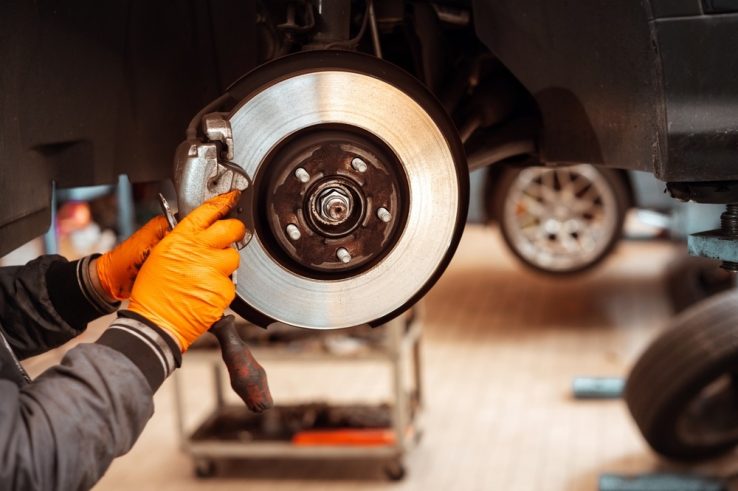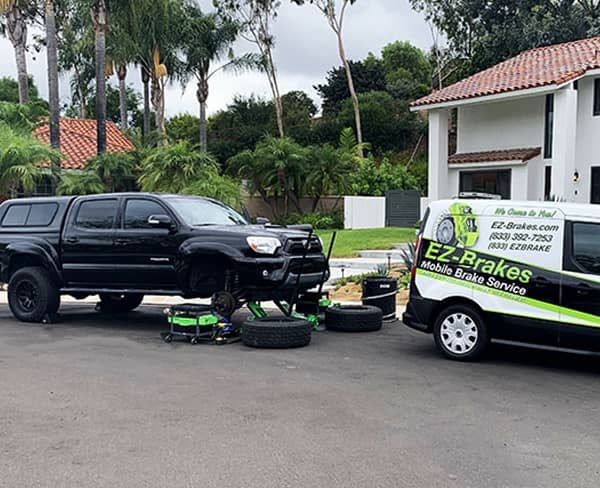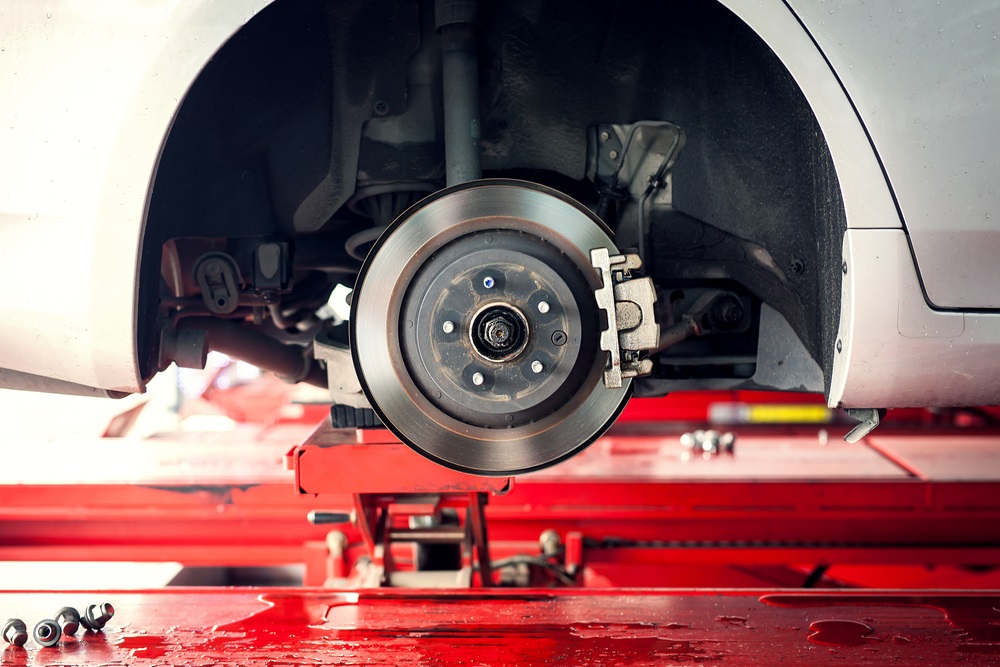When installing new brake pads and rotors on your vehicle, properly bedding them is essential to ensure optimal performance and long-lasting durability. Whether you’re a professional mechanic or an avid DIYer, learning how to bed brakes and rotors is key to maintaining the safety and efficiency of your braking system. At EZ-Brakes Mobile Brake Service, we’re here to help you understand the bedding process and guide you through how to properly bed new brake pads and discs, ensuring you enjoy miles of use from your vehicle’s braking system.
Why Bedding Brakes Is Crucial?
Bedding brakes involves creating an even layer of brake pad material onto the rotor’s surface to allow for optimal contact and performance. New pads and new rotors require a proper bedding process to ensure a smooth, effective interaction between these components. If this critical process is skipped, the brake pads may not make proper contact with the rotors, leading to issues like uneven wear, reduced stopping power, and noisy brakes.
What Happens During the Bedding Process?
When you install new disc brake pads, the pad compound needs to make proper contact with the rotor’s surface to ensure even braking. How to bed in new brake pads and rotors involves gradually heating up the pads and then performing aggressive stops to transfer an even layer of pad material onto the rotor. If this process isn’t done correctly, it can result in a glazed rotor, which impacts braking efficiency and safety.
Without proper bedding, your vehicle may face:
• Uneven brake pad wear
• Reduced stopping power
• Squealing or squeaking brakes
• Brake fade due to heat buildup
• Glazed rotors that result in poor braking performance
This is why learning how to bed brakes and rotors correctly is vital for safe driving. Proper bedding ensures smooth, effective braking, reduces the risk of damage to the rotors, and helps extend the lifespan of your brake components.
Read More: How to Bench Bleed a Master Cylinder Like a Pro?
Step-by-Step Guide: How to Bed in Brakes and Rotors
Properly bedding new brake pads and new rotors is an easy process that can be done at home with the right approach. Follow these steps to ensure your new disc brake pads and rotors are properly bedded for optimal performance.
1. Prepare Your Vehicle
Before starting the bedding process, make sure your vehicle is ready:
• Check the Brake Pad and Rotor Installation: Ensure that your new rotors and new pads are correctly installed. Misaligned pads or rotors can prevent the proper bedding process and cause uneven pad wear.
• Tighten All Fasteners: Use a torque wrench to ensure the bolts are tightened according to the manufacturer’s specifications. This ensures the pads and rotors are securely fastened.
• Inspect Brake Fluid Levels: Make sure the brake fluid is at the appropriate level. Low or old brake fluid can hinder braking performance and affect the bedding process.
2. Heat Up the Brakes Gradually
The next step is to gradually heat up the brake pads and rotors to the appropriate temperature. This helps to prevent thermal shock and allows for a smooth transfer of pad material to the rotor surface.
• Drive at Moderate Speed on Open Road: Start by driving on an open road at about 30-40 mph. Apply gentle, steady braking to gradually bring the new pads up to temperature. Avoid full stops during this phase.
• Avoid Full Stops: During this heating phase, avoid coming to a complete stop. Full stops can lead to uneven bedding, preventing the layer of brake pad material from forming evenly on the rotor.
• Repeat the Process for 10-15 Minutes: Apply light braking repeatedly over 10-15 minutes to evenly heat the new disc brake pads and the rotor’s surface.
By heating the brakes slowly, you prevent the hot brakes from developing hot spots or uneven wear patterns that would reduce braking performance.
3. Perform a Series of Aggressive Stops
Once your brakes are up to temperature, it’s time for the most critical part of bedding: the aggressive stops. This step allows for the proper transfer of the pad compound onto the rotor’s surface.
• Perform Hard Stops from 35-40 mph to 10-15 mph: Apply stronger braking pressure to achieve faster deceleration. Perform aggressive stops from a speed of around 35-40 mph to a slow roll at 10-15 mph.
• Cool Down Period Between Stops: After each aggressive stop, allow the brakes to cool for 30 seconds to 1 minute. This cooling period ensures that the heat generated during braking is dissipated, preventing the formation of a glaze on the rotor and allowing for an even layer of pad material to form on the rotor.
• Repeat 6-10 Times: Perform 6-10 aggressive stops at regular intervals, ensuring that each stop helps build up the correct layer of brake pad material on the rotor’s surface.
This phase is crucial for ensuring the brake pads and rotors mate properly, allowing for effective and smooth braking.
Read More: Why Are My Brakes Squeaking?
4. Cool Down the Brakes
After the series of aggressive stops, allow the brakes to cool down. This is important for maintaining even wear on the pads and preventing heat buildup.
• Drive for Several Miles: To ensure the cooling process is effective, continue driving at a moderate speed for several miles. This helps the new pads and rotors cool evenly.
• Avoid Using the Parking Brake: Avoid using the parking brake while the pads and rotors are still hot. Engaging the parking brake can cause uneven pressure on the pads and rotors.
Proper cooling ensures that the brake pad material bonds properly with the rotor’s surface and prevents the formation of unwanted hot spots or uneven wear patterns.
5. Test and Inspect
Once the bedding process is complete, it’s time to inspect your braking performance:
• Test for Squealing or Vibrations: If you hear squealing or notice vibrations during braking, it may indicate that the bedding process was not done properly. You may need to re-bed your brakes if issues arise.
• Check Braking Performance: Test your brakes at different speeds to ensure they’re stopping the vehicle efficiently and smoothly. Properly bedded brakes should feel responsive, with no noise or vibration.
What Happens If You Don’t Bed In Brakes?
If you skip the bedding process or don’t do it correctly, you may face issues such as:
• Uneven Pad Wear: Without bedding, the pads and rotors may not make even contact, leading to uneven brake pad wear and reduced performance.
• Brake Fade: Insufficient bedding can lead to brake fade as the pads and rotors overheat due to improper contact.
• Increased Brake Noise: Skipping the bedding process can cause squealing or grinding sounds when braking, a clear sign of improper pad and rotor contact.
Skipping or improperly bedding your brakes can lead to costly repairs and reduced braking performance, which compromises your safety on the road.
Essential Tools for the Brake Bedding Process
To perform the bedding process properly, you’ll need a few essential tools and preparations:
• Torque Wrench: Ensures that all fasteners are tightened to the manufacturer’s specifications, keeping your brake system secure.
• Brake Fluid: Ensure you’re using high-quality, fresh brake fluid for optimal performance.
• Temperature Gauge: Monitors heat buildup during the bedding process to prevent overheating.
• Safety Gear: Always use gloves and eye protection for safety.
Having the right tools and safety equipment ensures a smooth and effective bedding process, leading to improved brake performance.
Common Mistakes to Avoid When Bedding Brakes
To ensure you bed your brakes properly, here are some common mistakes to avoid:
• Avoiding Aggressive Stops: Some people hesitate to perform aggressive stops out of concern for damaging the brakes. However, this step is essential for transferring the layer of pad material onto the rotor’s surface.
• Skipping the Cooling Period: Not allowing time for the brakes to cool between stops can lead to uneven brake pad wear and poor braking performance.
• Improper Braking: Applying full pressure or coming to a complete stop before the pads have heated up can lead to a glazed rotor, making the bedding process ineffective.
• Bedding with Worn Pads: Always bed new pads and new rotors to ensure the process is effective. Using worn pads or components will result in poor performance.
FAQ About How to Bed Brakes
HOW TO BED BRAKES AND ROTORS PROPERLY?
Answer: To properly bed brakes and rotors, start by gradually heating the pads with moderate braking. Then, perform aggressive stops to transfer an even layer of brake pad material to the rotors. Allow for cooling periods between each stop.
HOW TO BED IN NEW BRAKE PADS AND DISCS?
Answer: Bedding in new brake pads and discs involves gentle heating, followed by a series of aggressive stops to transfer pad material onto the rotor. This process ensures that the pads and rotors establish a smooth, even braking surface.
HOW TO RE-BED BRAKES?
Answer: If your brakes are not performing optimally, re-bed your brakes by repeating the bedding process. This includes heating the pads, performing hard stops, and allowing time for cooling to ensure proper pad-to-rotor contact.
HOW TO BED BRAKES IN A CAR?
Answer: Bedding brakes in your car involves gradually heating the pads, performing a series of aggressive stops, and then cooling the brakes. This ensures that the brake pads form an even layer of pad material on the rotors for optimal performance.
Conclusion on How to Bed Brakes
At EZ-Brakes, we know that proper brake maintenance is essential to your vehicle’s safety and longevity. Understanding how to bed brakes is critical for achieving optimal braking performance and ensuring the even layer of brake pad material transfers smoothly onto the rotor’s surface. Whether you’re bedding in new pads and rotors or new disc brake pads, following the correct bedding procedure will help you avoid premature wear and ensure safer, more efficient driving for miles to come. Don’t skip this crucial step—your brakes will thank you for it! Take action today with our Mobile EZ-Brakes Service—we come to you, ensuring your brakes are properly bedded for safer, smoother rides ahead! Contact or call us at (833) 392-7253




